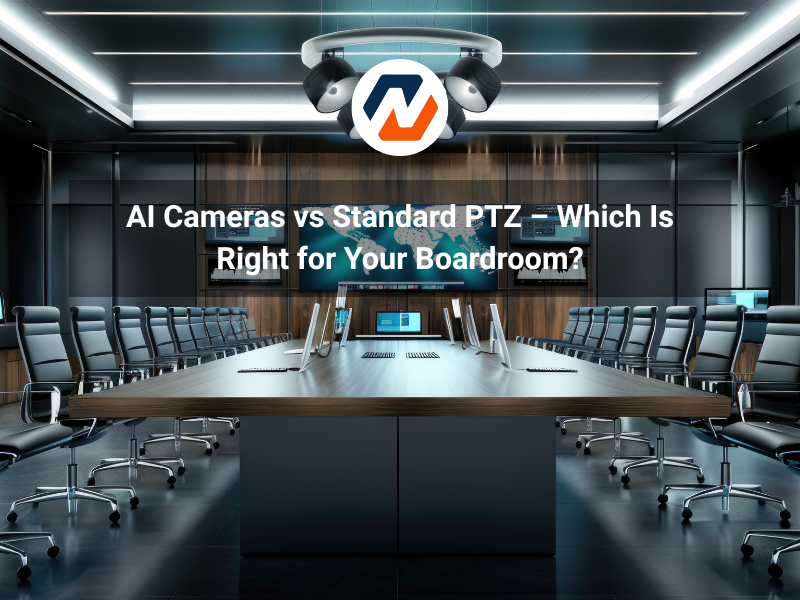admin2025-10-04T14:09:32+00:00
Table of Contents
ToggleIntroduction
Choosing the right camera for your conference room is one of the most important AV decisions your organization will make. In Canada, where hybrid meetings are now standard, companies are moving away from traditional PTZ (pan-tilt-zoom) cameras and exploring AI-powered cameras.
But which is better for your boardroom? The answer depends on your meeting room size, use cases, and budget. Let’s compare AI cameras vs PTZ cameras so you can make the right choice for your collaboration needs in 2025.
What Are PTZ Cameras?
Features:
- Mechanically pan, tilt, and zoom to capture participants.
- Usually controlled manually via remote or software.
- Offer strong optical zoom (great for large rooms).
Pros:
- High-quality zoom for big boardrooms or auditoriums.
- More affordable than advanced AI cameras.
- Proven technology used in enterprise AV for years.
Cons:
- Require manual adjustments (slow & distracting).
- Can miss participants if not adjusted properly.
- Narrower field of view than AI-driven solutions.
Use Case Example (Canada):
A Calgary law firm used PTZ cameras in their boardroom but often had to dedicate an IT staff member to control the camera manually—adding time and frustration to meetings.
What Are AI-Powered Cameras?
Features:
- Use artificial intelligence for auto-framing, speaker tracking, and wide-angle views.
- Recognize and frame multiple participants dynamically.
- Often include multi-lens systems for different views.
Pros:
- No manual control needed—AI automatically adjusts.
- Wide field of view ideal for hybrid equity (everyone is visible).
- Delivers a natural “in-room” experience for remote participants.
- Often integrates with Teams, Zoom, and Webex natively.
Cons:
- Higher upfront cost compared to PTZ cameras.
- Less optical zoom power (not ideal for very large auditoriums).
- Requires newer AV infrastructure for full benefits.
Use Case Example (Canada):
A Toronto financial institution installed AI cameras in its executive boardrooms. The bank reported a 41% improvement in remote participant engagement, as clients felt more included during hybrid meetings.
Direct Comparison: AI Cameras vs PTZ Cameras
| Feature | PTZ Cameras | AI-Powered Cameras |
|---|---|---|
| Control | Manual (remote/software) | Automatic (AI-driven) |
| Zoom | Strong optical zoom | Digital zoom + wide-angle |
| Coverage | Focused, limited view | Full-room, wide coverage |
| Meeting Equity | Lower (remote attendees excluded) | Higher (everyone framed equally) |
| Ideal Room Size | Large auditoriums | Small–medium boardrooms, hybrid rooms |
| Cost | Lower upfront | Higher upfront, but ROI in adoption |
2025 Trends: Canadian Companies Moving to AI Cameras
- 70% of new corporate boardroom installations in Canada (2025) include AI-powered cameras (AV Canada Trends Report).
- Enterprises with AI cameras reported 29% faster adoption by employees compared to PTZ setups (Microsoft Canada, 2025).
- Government agencies upgrading to AI cameras saw 36% higher meeting equity scores (Canadian Public Sector Report, 2025).
What Are AI-Powered Cameras?
Choose PTZ Cameras if:
- You have very large rooms or auditoriums where optical zoom is critical.
- You want a budget-friendly option for basic video coverage.
- You have IT staff available to manage cameras during meetings.
Choose AI Cameras if:
- You host frequent hybrid meetings with remote participants.
- You want hands-free automation for smoother meetings.
- You prioritize meeting equity and employee engagement.
- You’re building future-proof AV systems for the hybrid workplace.
Conclusion
Both PTZ and AI-powered cameras have their place in modern AV setups. However, as Canadian organizations shift to hybrid-first work models, AI cameras are becoming the go-to solution for boardrooms, classrooms, and government meeting spaces.
✅ If you run a large auditorium, PTZ may still be the best choice.
✅ If you want seamless hybrid equity and hands-free automation, AI cameras are the future.

